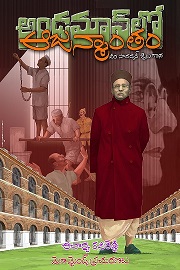"I believe that a nation held down by foreign bayonets is in a perpetual state of war. Since open battle is rendered impossible to ...
"I believe that a nation held down by foreign bayonets is in a perpetual state of war. Since open battle is rendered impossible to a disarmed race, I attacked by surprise. Since guns were denied to me I drew forth my pistol and fired. Poor in health and intellect, a son like myself has nothing to offer the mother but his own blood. And so I have sacrificed the same on her altar. The only lesson required in India at present is to learn how to die, and the only way to teach it is by dying ourselves."
Extract from speech in court, July 23rd 1909
---------------------------------------------------------------
Madanlal Dhingra was born in the holy city of Amritsar, the son of a well respected doctor, who was very loyal to the British. After some time as a civil servant, Dhingra went to England, to study engineering, in June 1906. In England, Dhingra enjoyed the "good life." He used to wear expensive clothes and fragrances, spend ages on his appearance and made many English friends and was very socially active. He was a charmer, but always loved his religion and Motherland as we are about to see.
There was a house in London that was known as India House, on Cromwell Street. This was set up by Shyamji Krishna Verma. The struggle for India’s freedom was under way, and at India house resided one of its great heroes, Veer Savarkar. He used to gather many Indian students, and give speeches and hold discussions to inspire them to serve the cause of the upliftment of India. Savarkar was a skilful orator and many heeded his message. Madanlal heard of India House and decided to pay it a visit. There he heard Savarkar speak, and as he listened, his blood began to boil. Strong feelings of anger and were aroused within him which were difficult for him to control. He became a great friend and devotee of Veer Savarkar, and took the oath of the Abhinava Bharat (meaning "Young India") revolutionary society founded by him.
A few incidents show Madanlal’s endurance and fiery patriotism. Savarkar organised a day in commemoration of the anniversary of India’s 1st war of Independence in 1857 (which the British dubbed as the "Indian Mutiny"). Hundreds of Indian youth went about for the day with a badge titled "1857 - Commemoration," to the annoyance of many English. An English friend of Dhingra tried to grab the badge of him. Dhingra slapped him, punched him to the ground drew a knife, saying "Don’t dare touch the symbol of my country’s honour." The Englishman apologised and fled. One day, at India House, a group was speaking of the bravery and prowess of the Japanese (who had just defeated Russia in a war), speaking of them as the pride of Asia. After a while, Dhingra got angry. "Enough of the praise of the Japanese, do you suppose we Hindus are in any way inferior to them?" In the eyes of many Dhingra was just a pretty boy and joker. Many of those present burst out laughing at his words, and taunted him. Dhingra was infuriated. This escalated, and led to a disturbing challenge being proposed to test Dhingra’s fortitude. Someone sugested in jest that a needle should be put through Dhingra’s hand. Dhingra absolutely insisted on the challenge, despite others now trying to discourage him. The needle was put all the way through the palm of his hand. Blood flowed, those present cringed, but Dhingra just smiled. The secret society started by Savarkar (Abhinava Bharat), were making bombs and procuring arms to send to India. In one bomb making session, the concentration of those present lapsed. Dhingra’s intuition and alertness prevented a serious calamity. He stopped the immanent explosion, but was burnt in the process.
Continually hearing the plight of Indians, and the increasingly oppressive measures that were being taken in the wake of the intensifying freedom movement, Dhingra was enraged, One day he appeared before Savarkar, saying he wanted to sacrifice himself, and asked if the time was right. Savarkar replied that it was nobody else’s decision, but that Dhingra himself would know when the time was right. A long discussion followed, and various plans were thought out. Dhingra’s anger against British occupation of his motherland increased day after day. To top it off, Savarkar’s elder brother was imprisoned and deported to the Andamans (a famous high security prison). Dhingra was determined to make the British taste a bit of revenge. He brought a revolver and practised shooting.
Dhingra began to look for India haters within his site. There was an association in London called the National Indian Association (NIA). Lord Curzon Wyllie was an important member of its committee. He had been a secretary of State in India, perceived to have been responsible for several ills against the Indian people, and the NIA was actively de-Indianising the Indian youth who were part of it, "turning patriotic young men into immoral useless traitors." Dhingra became friends with its secretary Emma Beck and became a member of the organisation, also getting to know Lord Curzon. Dhingra chose the night of 1st of July at a party of the NIA, at Jahangir House of the Institute of Imperial Studies, to be the date of his retaliation against the British. The music session was just over when Curzon Wyllie entered the hall with his wife. Dhingra approached him, and fired 5 shots killing Curzon. Dhingra fired a 6th bullet when Cowasji Lalkaka, a Parsi gentlemen, dashed towards and grabbed Dhingra. Lalkaka also fell dead. Dhingra stated in court that he had no intention of killing Cowasji Lalkaka. The police arrived, and Dhingra willingly allowed his arrest.
Needless to say, England was rocked by the murder of Curzon Wyllie. Dhingra had written a statement, but the police snatched it and it was never again seen. However, Savarkar had a copy in anticipation of the police action. The Indian freedom fighters were overjoyed, but many Indians openly condemned him. Unfortunately these included his anglophile father and brother, who disowned him publicly. A meeting was held in Caxton Hall in London on the 5th July 1909, as a meet up of the prominent Indians who were loyalists to the British Raj, to pass a resolution in condemnation of Madanlal Dhingra’s conduct. Word of this meeting reached Dhingra’s friends, and a band of them attended the meeting. The Aga Khan, who presiding over the meeting moved to pass a resolution unanimously condemning Dhingra. Savarkar’s voice interrupted loudly from the back of the hall. "No, the resolution is not unanimous." The whole gathering was silenced. "Who is that?" shouted the Aga Khan. "It is me Savarkar, and I condemn it" was the reply. A young British man dashed forward and punched Savarkar to the floor. Savarkar was bleeding, and his glasses smashed, but he continued, "Happen what may, I oppose the resolution." Then Thirumalacharya, a fellow revolutionary thrashed the Englishmen who hit Savarkar, forcing him to flee. The Abhinava Bharat would suffer no insult to their beloved Dhingra.
The court case, which followed, was held at the Old Bailey Court on July 23rd. The outcome was a foregone conclusion. But it was perhaps here that was Dhingra’s finest hour. He faced the ordeal calmly and gave a voice to the suffering of his beloved Mother India. Part of his statement (delivered on July the 10th) read as follows:
"I do not want to say anything in defence of myself but simply to prove the justification of my deed. As for myself I do not think any English law court has any authority to convict me or detain me in prison or to pass any sentence against me... I hold the English responsible for the murder of 8 million of my countrymen in the last 50 years."

Up to the date of his execution, many friends came to visit Dhingra. His only formal request was very simple - that his funeral should be done in the traditional Hindu manner. Savarkar was determined to do something for Dhingra. He activated his contacts in several countries. There were indeed several non-Indians, even Britishers, who believed in India’s freedom. Dhingra’s statement was sent to major newspapers across the world, all of who published it! This was a very key event in giving momentum to the freedom movement, as many foreign voices now raised their voices in India’s favour. Dhingra certainly didn’t die in vain. In Ireland and Egypt (which were both involved in a struggle against the British), Dhingra was a hero. Annie Besant rightly said of Dhingra "More Madanlal’s are the need of the time." Later on, Madanlal Dhingra’s deeds would inspire the great martyrs Bhagat Singh and Uddham Singh.
On the day of Dhingra’s martyrdom, he had the names of Ram and Krishna on his lips. His friends printed a handout and gave it out on the streets, praising Dhingra’s sacrifice and the injustices being perpetrated against India, together with a warning that the struggle will not subside. Dhingra died with the Bhagwad Geeta in his hands. His parting words were:










No comments